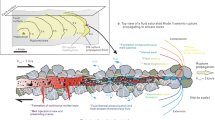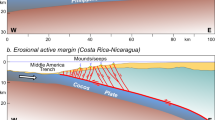Abstract
RECENT seismological, heat flow and stress measurements in active fault zones such as the San Andreas have led to the suggestion1,2 that such zones can be relatively weak. One explanation for this may be the presence of overpressured fluids along the fault3–5, which would reduce the shear stress required for sliding by partially 'floating' the rock. Although several mechanisms have been proposed for overpressurizing fault fluids3,4,6,7, we recall that 'pressure seals' are known to form in both sedimentary8 and igneous9 rocks by the redistribution of materials in solution; the formation of such a seal along the boundaries of a fault will prevent the communication of fluids between the porous, deforming fault zone and the surrounding country rock. Compaction of fault gouge, under hydrostatic loading and/or during shear, elevates pore pressure in the sealed fault and allows sliding at low shear stress. We report the results of laboratory sliding experiments on granite, which demonstrate that the sliding resistance of faults can be significantly decreased by sealing and compaction. The weakening that results from shear-induced compaction can be rapid, and may provide an instability mechanism for earthquakes.
This is a preview of subscription content, access via your institution
Access options
Subscribe to this journal
Receive 51 print issues and online access
$199.00 per year
only $3.90 per issue
Buy this article
- Purchase on Springer Link
- Instant access to full article PDF
Prices may be subject to local taxes which are calculated during checkout
Similar content being viewed by others
References
Zoback, M. D. et al. Science 238, 1105–1111 (1987).
Hickman, S. H. in US. Nat. Rep. int. Un. Geodesy Geophys. 1987–1990, Rev. Geophys. Suppl., 759–775 (1991).
Lachenbruch, A. H. J. geophys. Res. 85, 6097–6112 (1980).
Byerlee, J. Geophys. Res. Lett. 17, 2109–2112 (1990).
Rice, J. R. in Fault Mechanics and Transport Properties in Rocks (the Brace volume) (ed. Evans, B. & Wong, T.-F.) 475–503 (Academic, London, 1992).
Sibson, R. H. Nature 243, 66–68 (1973).
Fournier, R. O. EOS 71, 1635 (1990).
Powley, D. E. Earth Sci. Rev. 29, 215–226 (1990).
Fournier, R. O. Geophys. Res. Lett. 18, 955–958 (1991).
Blanpied, M. L., Lockner, D. A. & Byerlee, J. D. Geophys. Res. Lett. 18, 609–612 (1991).
Morrow, C. A., Moore, D. E. & Byerlee, J. D. Mat. Res. Soc. Proc. 44, 467–473 (1985).
Summers, R., Winkler, K. & Byerlee, J. J. geophys. Res. 83, 339–344 (1978).
Smith, D. L. & Evans, B. J. geophys. Res. 89, 4125–4135 (1984).
Sprunt, E. S. & Nur, A. Geophysics 42, 726–741 (1977).
Cox, S. F. & Paterson, M. S. Geophys. Res. Lett. 18, 1401–1404 (1991).
Lockner, D. A. thesis, Massachusetts Inst. Technol. (1990).
Marone, C. & Scholz, C. H. Geophys. Res. Lett. 15, 621–624 (1988).
Morrow, C. A. & Byerlee, J. D. J. struct. Geol. 11, 815–825 (1989).
Angevine, C. L., Turcotte, D. L. & Furnish, M. D. Tectonics 1, 151–160 (1982).
Fredrich, J. T. & Evans, B. EOS 72 (Fall mtg. Suppl.) 441 (1992).
Burnham, C. W., Holloway, J. R. & Davis, N. F. Thermodynamic Properties of Water to 1,000 °C and 10,000 Bars (Geol. Soc. Am., Boulder, Colorado, 1969).
Brace, W. F., Walsh, J. B. & Frangos, W. T. J. geophys. Res. 73, 2225–2236 (1968).
Brantley, S. L., Evans, B., Hickman, S. H. & Crerar, D. A. Geology 18, 136–139 (1990).
Walder, J. & Nur, A. J. geophys. Res. 89, 11539–11548 (1984).
Hunt, J. M. Am. Assoc. Petrol. Geol. Bull. 74, 1–12 (1990).
Ramsey, J. G. Nature 284, 135–139 (1980).
Sibson, R. H., Robert, F. & Poulsen, K. H. Geology 16, 701–704 (1988).
Behrmann, J. H. Earth planet. Sci. Lett. 107, 550–558 (1991).
Walsh, J. B. J. geophys. Res. 76, 8597–8598 (1971).
Chester, F. M. & Logan, J. M. Pure appl. Geophys. 124, 79–106 (1986).
Power, W. L. & Tullis, T. E. J. struct. Geol. 11, 879–893 (1991).
Frohlich, C. A. Rev. Earth planet. Sci. 17, 227–254 (1989).
Wannamaker, P. E., et al. J. geophys. Res. 94, 14127–14144 (1989).
Meade, C. & Jeanloz, R. Science 252, 68–72 (1991).
Kirby, S. H. J. geophys. Res. 92, 13789–13800 (1987).
Burnley, P. C., Green, H. W. & Prior, D. J. J. geophys. Res. 96, 425–443 (1991).
Lockner, D. A., Summers, R. & Byerlee, J. D. Pure appl. Geophys. 124, 445–469 (1986).
Author information
Authors and Affiliations
Rights and permissions
About this article
Cite this article
Blanpied, M., Lockner, D. & Byerlee, J. An earthquake mechanism based on rapid sealing of faults. Nature 358, 574–576 (1992). https://doi.org/10.1038/358574a0
Received:
Accepted:
Issue Date:
DOI: https://doi.org/10.1038/358574a0
This article is cited by
-
Strain characteristics and permeability evolution of faults under stress disturbance monitoring by fibre bragg grating sensing and pressure pulses
Geomechanics and Geophysics for Geo-Energy and Geo-Resources (2021)
-
Episodic creep events on the San Andreas Fault caused by pore pressure variations
Nature Geoscience (2018)
-
Fractal asperities, invasion of barriers, and interplate earthquakes
Earth, Planets and Space (2014)
-
Inferring fault strength from earthquake rupture properties and the tectonic implications of high pore pressure faulting
Earth, Planets and Space (2014)
-
On the geoelectric structure of major strike-slip faults and shear zones
Earth, Planets and Space (2014)
Comments
By submitting a comment you agree to abide by our Terms and Community Guidelines. If you find something abusive or that does not comply with our terms or guidelines please flag it as inappropriate.



